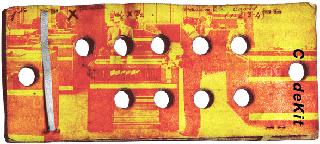


| URL: | http://netzspannung.org/database/125345/de |
| Last update: | 19.02.2004 |
| Date of print: |
 |
Code KIT Abschlussveranstaltung |
Kurzdarstellung
Kurzbeschreibung
Die Software txtkit ist ein kollektives Expertensystem, das die maschinelle und inhaltliche Analyse von textueller Information visualisiert. Nicht die umfassende und semantische Analyse eines Textes steht im Vordergrund, sondern die dynamische Darstellung strukturierter und numerischer Textdaten, sowie deren Transformation durch serielle Lekt¨uren und Montagen. Statt der Anwendung statischer und vordefinierter Parameter und Wissensbasen, stehen die sich kontinuierlich aendernden Modalitäten dynamischer Wissensentwicklung im Vordergrund. Hierfür wurde ein innovatives Datenbanksystem und ein Textparsingprogramm zur Materialaufbereitung
entwickelt, welches die Erschliessung der Information visualisiert und den Kriterien der Relevanz und Repräsentativität anpasst.
Das zweiteilige Interface der Software begünstigt zudem das Zusammenspiel von schriftsprachlicher und visueller Wissensexploration, mit dem Ziel
veränderte Verfahren zur Erkenntnisgewinnung in den Blick zu bekomm.
KünstlerInnen / AutorInnen
- Anne Pascuale
- Marcus Hauer › Biografie
[link 02]
Termin
- 24. Oktober 2003
Veranstalter
Kunsthochschule für Medien Köln
Veranstaltungsort
Kunsthochschule für Medien Köln, Overstolzenhaus, Rheingasse 8, Köln, Deutschland
Partner / Sponsoren
Code KIT, KHM
Eingabe des Beitrags
, 19.02.2004
Kategorie
- Symposium |
- Vortrag
Schlagworte
- Themen:
- Interface |
- Kommunikation |
- Kollaboration |
- Informationsarchitektur |
- Informationsdesign |
- Community |
- Datenbank |
- Vernetzung |
- Internet |
- E-Learning |
- Interaktivität |
- Artistic Software
Inhalt
Inhaltliche Beschreibung
What is txtkit?
txtkit is a visual text mining tool for exploring large amounts of multilingual texts. It's a multiuser-application which mainly focuses on the process of reading and reasoning as a series of decisions and events. To expand this single perspective activity txtkit collects all of the users mining data and uses it to create content recommendations through collaborative filtering. The software requires Mac OS X 10.3 and Internet access.
Interface:
The txtkit interface is divided into two parts: txtshell (shell interface) and txtvbot (visual bot). txtshell provides several commands to browse, to read and to select text, whilst the txtvbot displays the user activity in real-time. The visualization is based on the users actions, statistical information about the data as well as collaborative filtering schemes. You can use the txtvbot and the txtshell individually, but through an alternating perception you will merge visual and textual cognition processes meeting the potential of digital hypothesis formation.
Structure:
Main parts of txtkit are: a parsing programm, a mysql database running on a server and the txtkit client divided in txtshell (terminal application) and txtvbot (for cocoa opengl). After you installed txtkit on your computer you will automatically connected with the txtkit database. txtkit 1.0 runs with german texts on media art theory written by Hans Ulrich Reck. Other texts and languages will be soon available. For more information on the structure please check the overview section.
Background:
txtkit was commissioned by Prof. Hans Ulrich Reck - project director with Prof. Georg Trogemann of KIT (Kunst. Informatik. Theorie.), a research project based at the Art and Media Studies department at the Academy of Media Arts Cologne. KIT is a part of the KUBIM programme. KUBIM can be seen within the larger context of concepts and programmes in Germany to help build the global "Information Society".
Under the umbrella of the Bund-Länder-Kommission für Bildungsplanung und Forschungsförderung (BLK), a joint body of the Federal Government and the Länder for educational planning and research funding, kubim was launched in Spring 2000 to develop and test innovative models for the creative and competent use of new media-technologies in cultural education and training.
KUBIM is financed by the Federal Ministry for Education and Research (BMB+F) and Länder Ministries for Education or Science and Culture.
Goals:
The aim of the KIT project was to investigate the potential of the new technologies with regard to visual arts, design and theoretical research. SW/OfCD were asked to develop a prototype which introduces new methods for exploring and dealing with large textual sources.
Time:
txtkit research and development started in March 2002 and finished in January 2004.
Kontext
|
|
| » http://www.schoenerwissen.com |
|
|